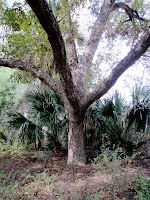The Sarapiqui River drains the watershed from the highlands to the west to the Caribbean to the east. Normally the river rushes clear with rapids perfect for adventure sports. However, abnormally heavy rains have washed thick brown sediments out of the highlands. The river is higher than normal and chocolate brown. To reach the rain forest preserve at Tirimbina biological Reserve, we cross the Sarapiqui River on a suspension bridge.
The river cuts through the Tirimbina Biological Reserve that contains both primary and secondary growth rain forest. The differences between the two types of forests is apparent. The primary forest has a well developed canopy and only a few understory of plants that are adapted to capturing light with large leaves. A walk along the trail at the edge of this jungle is a step back to the Cretaceous period, except that the cycads and ferns are small while flowering plants and trees are tall.
The understory of the secondary forest is dense with small trees and flowering plants. The canopy is lacy and open barely filtering light down to the highly populated understory.
What type of forest is shown in the image? Explain.
Notice the small holes that ants use to enter and exit the trunk.
Listen to the sound of the hollow trunk.
Listen to the sound of the hollow trunk.

























